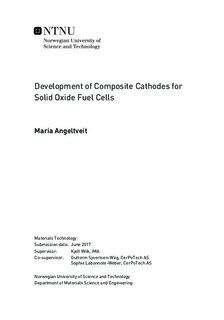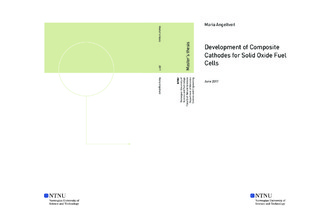| dc.description.abstract | Solid oxide fuel cells have the potential to become an important device for clean energy production. Today, these cells run at high temperatures, which causes degradation in the cell components and a short life-time of the device. To increase the life-time for the device to be economically beneficial, the operating temperature needs to be reduced. For this, new materials that gives a low area specific resistance (ASR) at low temperatures need to be developed. Two composite materials have been investigated for cathode performance, both consisting of 70 % Ce0.9Gd0.1O2-x and 30 % La0.6Sr0.4Co0.2Fe0.8O3-x. Composite A was directly spray-pyrolysed by CerPoTech AS, consisting of a more intimate mixture of the two materials, thus a higher density of reaction cites for the oxygen reduction reaction to occur. Composite B was mechanically mixed using pure components, also delivered by CerPoTech AS. Dense CGO pellets were produced, and composite cathode was deposited using an air-brush technique. Each sample was heat-treated at 650-1150 °C with a 100 °C interval. SEM-analysis of the cross-sections was conducted to evaluate the adhesion of cathode to electrolyte. Further, symmetric cells with Composite A and Composite B, heat treated at 950 °C and 1050 °C, were tested at 600 °C, 700 °C and 800 °C in dry air atmosphere. The area specific resistance (ASR) at each operating temperature and the activation energy was calculated. Composite A had a lower ASR for all operating temperatures and for both heat treatment temperatures. The difference in ASR between the two composites heat treated at 950 °C was significant, Composite A a having an ASR comparable to literature values. The activation energy was closer to the activation energy for the oxygen surface exchange reaction, suggesting that this was the dominating rate-limiting process in the cathode. Comparing to pure LSCF cathode in literature, Composite A at 950 °C had a significantly lower ASR at operating temperature 600 °C and low activation energy. The results for Composite A is explained by the synthesis method, giving fine grained material with a high density of triple phase boundaries. The lower ASR at 600 °C compared to pure LSCF was believed to be due to a high ionic conductivity of CGO at lower temperatures. A spray-pyrolysed composite material is promising for the use in solid oxide fuel cells, due to a low ASR and activation energy at lower operating temperatures. | |

